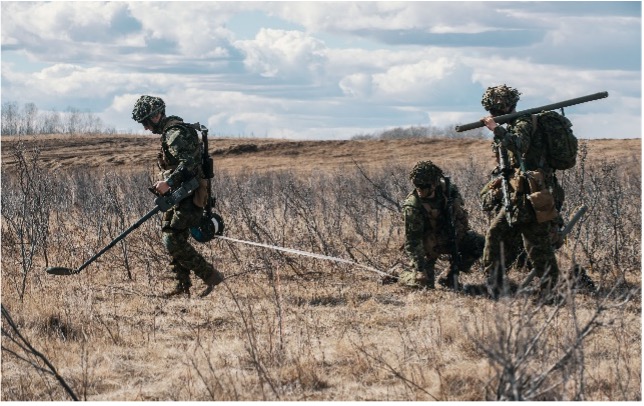Even during peacetime, de-mining is a challenge.
The ability to detect and dispose of mines in a war zone could be complicated by shrapnel interfering with metal detectors, improvised explosive devices, thick vegetation, and other factors. This means clearing a path is slow, meticulous, and dangerous.
Combine this with active fire, barriers, constant surveillance and remote detonation, and minefield breaching during combat is about as onerous a task as can be undertaken during operations.
In Ukraine, minefields have evoked images of World War I era fighting, with a complicating twist of modern technology and unmatched depth.
The modern minefields constructed are up to 10 kilometres deep. The advent of drones provides near constant surveillance, and enemies can now scatter fresh mines from the air after the initial ones have been disposed. It’s a modern standoff tool that has proven to be harshly effective in bringing offensive operations to a standstill.
To breach a contemporary minefield, you need a modern approach. That’s why the Innovation for Defence Excellence and Security (IDEaS) program launched the Safer passage during minefield breaching operations in Ukraine challenge in March of this year.
“It’s a complicated challenge and we don’t expect one solution to solve the entire problem.
The situation is complicated and fluid, and we are looking for anything that can help get troops and equipment through a minefield during operations to help Ukraine move forward,” says Philippe Hébert, Director General, Innovation and head of the IDEaS program.
The concept is straightforward: develop or combine technologies in a way that can help clear a path for troops quickly and safely. The solution, however, is far from simple.
The process began by creating situational awareness. Stakeholders gathered at a Mission Analysis Session in January 2024 to help properly scope the problem. The hope was that there may also be potential solutions that could be tested and deployed in short order from Canadian innovators working in this field.
Stakeholders were provided firsthand insights gained by Ukrainian military personnel. The Ukrainian Ministry of Defence, Defence Forces, and the Ukrainian frontline innovation unit BRAVE1 provided on-the-ground situational reports. Canadian military observations and expertise was also shared by members of the Operation UNIFIER Task Force.
While the ideal scenario would be to uncover mission-ready technology from the Canadian innovation ecosystem, the Mission Analysis Session report concluded that concept development was required to produce functional technology.
As a result, the IDEaS program invited innovators with promising concepts to qualify to receive funding for up to 12 months, with the possibility to demonstrate their technology to military experts at the conclusion of their funding.
While the challenge is only open to Canadian innovators, the hope is that they will collaborate with their Ukrainian counterparts. Successful Canadian innovators will receive funding to develop their concepts and can use a portion of their funding to hire international contractors to support them in their efforts.
“There is an opportunity for Canadian companies to work with Ukrainian companies by subcontracting with Ukrainian firms to provide test spaces, design, components or other critical aspects of the technologies companies are building,” Hébert says.
In all likelihood, successful approaches will “stack” technologies, combining two or more existing technologies for a more effective approach. For example, drone technology, combined with thermal imaging technology, could scan and detect differences in soil temperature at scale, as buried mines heat and cool at different rates than regular soil. This is just one example.
The response so far has been enthusiastic.
“The opportunity to partner with Canadian and Ukrainian companies to assist our ally is proving to be a big draw so far. We have had 80 expressions of interest, and the challenge has only been open for a couple of weeks,” Hébert says. “We are excited to see where innovators can take this.”
A key signatory of the Ottawa Treaty banning anti-personnel land mines, Canada has long been a leader in civilian mines clearance. The hope is that technologies developed through this challenge will become dual-use for civilian de-mining initiatives.
The challenge is now open until May 28. For more information, visit the Safer passage during minefield breaching operations in Ukraine challenge web page.

